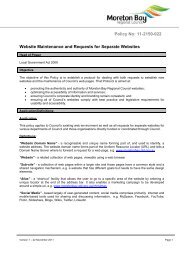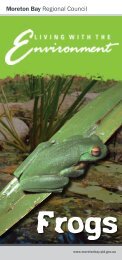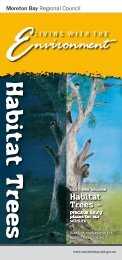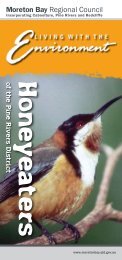Caboolture Region Water Quality Study - Moreton Bay Regional ...
Caboolture Region Water Quality Study - Moreton Bay Regional ...
Caboolture Region Water Quality Study - Moreton Bay Regional ...
Create successful ePaper yourself
Turn your PDF publications into a flip-book with our unique Google optimized e-Paper software.
Saltwater Creek<br />
Table 10. <strong>Water</strong> quality assessments for Saltwater creek, 2001. These ratings represent assessments based on water quality<br />
data for the period October 2000 to September 2001. The dots indicate the latest water quality assessment in comparison to the<br />
Queensland <strong>Water</strong> <strong>Quality</strong> Guidelines (green= good, yellow= moderate, red= poor, grey= insufficient data or median was<br />
detection limit which was greater than the guidelines). The arrows indicate trends in median concentrations over the last 3<br />
years. The colour of the arrow indicates whether the water quality has improved (green) or deteriorated (red), and the direction<br />
of the arrow shows whether the median increased (up) or decreased (down). Double-ended arrows (black) indicate variable<br />
trends.<br />
Site<br />
<strong>Water</strong> Type<br />
Stream<br />
Source<br />
pH<br />
Conductivity<br />
Dissolved<br />
Oxygen<br />
Turbidity<br />
Secchi Depth<br />
Oxidised<br />
Nitrogen<br />
Ammonia<br />
Total Nitrogen<br />
Total<br />
Phosphorous<br />
Chlorophyll a<br />
Organic N<br />
FRP<br />
FINAL<br />
SAL-1 LC Saltwater Ck CSC <br />
SAL-2 LC Saltwater Ck CSC <br />
SAL-3 LC Saltwater Ck CSC <br />
SAL-4 LC Saltwater Ck CSC <br />
SAL-5 LC Saltwater Ck CSC <br />
SAL-6 LC Saltwater Ck CSC <br />
SAL-7 LC Saltwater Ck CSC <br />
SAL-8 LC Saltwater Ck CSC <br />
SAL-9 LC Saltwater Ck CSC <br />
The retention structure site also had poor sediment quality, with arsenic, chromium, copper, nickel,<br />
lead, zinc and mercury all above the ANZECC high trigger levels. In June 2000, the site adjacent to<br />
this retention structure recorded sediment toxicant concentrations similar to those recorded within the<br />
structure. In January 2001, the site upstream of the structure also recorded elevated sediment toxicant<br />
levels. However, this site is located at a stormwater discharge pipe and many of these metals have<br />
been previously linked to urban stormwater run-off (Moss and Costanzo, 1998). Both of these events<br />
were not detected in later sampling (Table 10). Concentrations of mercury, lead and zinc at some of<br />
the upstream sites were also found to be above the ANZECC low trigger levels<br />
Fish and macro-invertebrate studies have reported mixed results for Saltwater Creek. Macroinvertebrate<br />
investigations failed to indicate either good or poor water quality at all sites, other than at<br />
one of the more upstream sites, which was in good ecological condition (SCCMAP, 1999). The most<br />
abundant fish species at most sites was Gambusia holbrooki (mosquitofish), which is frequently<br />
associated with poorer water quality and degraded stream habitat. Native gudgeons (Hypseleotris<br />
spp.) dominated only one upstream site.<br />
The upstream section of Saltwater Creek (SC1-8) had moderate riparian vegetation integrity and the<br />
size was rated as good despite being situated in an industrial land-use area (Appendix G, ANA, 1998).<br />
In the residential areas downstream of SC8, the size and integrity of riparian vegetation were both<br />
good (Appendix G, ANA, 1998).<br />
Median concentrations of faecal coliforms were high at all sites within Saltwater Creek, except for the<br />
most upstream site (SAL-1; Table 11), which is located at the upstream margin of the industrial area.<br />
All sites downstream of SAL-1 had elevated concentrations of faecal contamination, indicating<br />
potential sources of faecal contamination from within the industrial area.<br />
24



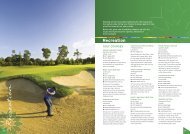
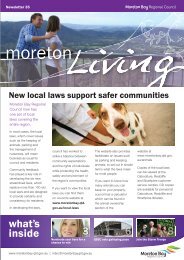
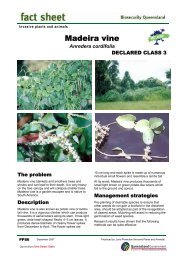
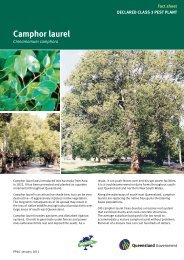


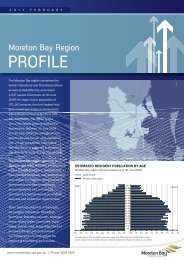
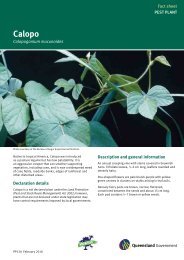

![Kumbartcho Brochure [PDF 540KB] - Moreton Bay Regional Council](https://img.yumpu.com/47220970/1/190x101/kumbartcho-brochure-pdf-540kb-moreton-bay-regional-council.jpg?quality=85)
